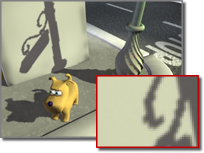Sample Range affects the softness of the edge of shadow-mapped shadows. The sample range determines how much area within the shadow is averaged.

Low sample range can cause jagged-edged shadows.

Higher sample range causes soft-edged shadows.
Small values reduce the area that is averaged, effectively bringing the edge of the shadow inward, producing sharper-edged shadows. Sharper edges can cause aliasing.
Large values extend the area that is averaged, effectively bringing the edge of the shadow outward, producing softer-edged shadows. Soft-edged shadows have more antialiasing. The effect is somewhat like the falloff of a soft-edged spotlight.
The default Sample Range value is 4. The Sample Range value can be any floating-point number from 0 to 20. Values of 2 to 5 are recommended. Values below 3 can produce coarse-edged shadows. You can reduce this effect by increasing the map size.
Values greater than 5 can produce streaking and moiré patterns. You can reduce this effect by increasing the map size or the Bias value.
Rendering time increases exponentially as the Sample Range value increases.